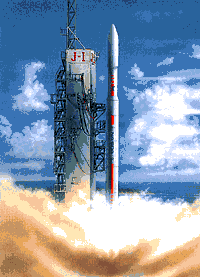J-1 (Japanese rocket)

The J-1 was a Japanese three-stage solid fuel rocket intended to place payloads of about 1,000 kilograms into low Earth orbit. It was the first launch vehicle in Japan to be made from a combination of existing indigenous rockets – the solid rocket booster of the H-2 (see H series) and the upper stage of the M-3S II (see M series).
The Japanese space agency NASDA had hoped that using existing systems would keep cost and development time down. However, when a report showed that the J-1 program cost more than similar projects in other countries, NASDA switched instead to developing a more capable rocket using less expensive parts imported from overseas. A study was carried out on a J-1 Upgrade (J-1A) launch vehicle. This would have employed a single Russian NK-33 first stage engine and fuel tanks derived from the Atlas, and been able to place approximately 3,500 kilograms into a 160-kilometer-high orbit and 1,000 kilograms into a sun-synchronous orbit. The first test flight had been planned for 2003 but never took place.


